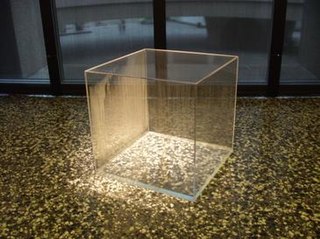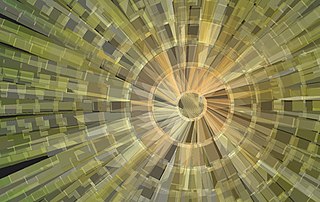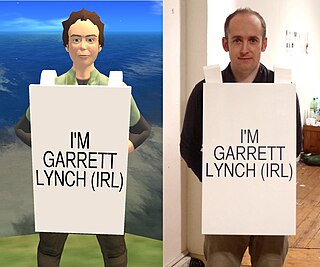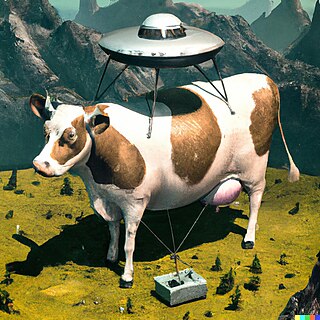
Artificial intelligence (AI) is the intelligence of machines or software, as opposed to the intelligence of humans or animals. It is also the field of study in computer science that develops and studies intelligent machines. "AI" may also refer to the machines themselves.

Digital art refers to any artistic work or practice that uses digital technology as part of the creative or presentation process. It can also refer to computational art that uses and engages with digital media.

Generative art refers to art that in whole or in part has been created with the use of an autonomous system. An autonomous system in this context is generally one that is non-human and can independently determine features of an artwork that would otherwise require decisions made directly by the artist. In some cases the human creator may claim that the generative system represents their own artistic idea, and in others that the system takes on the role of the creator.
Computer art is any art in which computers play a role in production or display of the artwork. Such art can be an image, sound, animation, video, CD-ROM, DVD-ROM, video game, website, algorithm, performance or gallery installation. Many traditional disciplines are now integrating digital technologies and, as a result, the lines between traditional works of art and new media works created using computers has been blurred. For instance, an artist may combine traditional painting with algorithm art and other digital techniques. As a result, defining computer art by its end product can thus be difficult. Computer art is bound to change over time since changes in technology and software directly affect what is possible.

Derrick de Kerckhove is the author of The Skin of Culture and Connected Intelligence and Professor in the Department of French at the University of Toronto, in Toronto, Ontario, Canada. He was the Director of the McLuhan Program in Culture and Technology from 1983 until 2008.
Royalty-free (RF) material subject to copyright or other intellectual property rights may be used without the need to pay royalties or license fees for each use, per each copy or volume sold or some time period of use or sales.

Algorithmic art or algorithm art is art, mostly visual art, in which the design is generated by an algorithm. Algorithmic artists are sometimes called algorists.

Maurice Benayoun is a French new-media artist, curator, and theorist based in Paris and Hong Kong.

Maurizio Bolognini is a post-conceptual media artist. His installations are mainly concerned with the aesthetics of machines, and are based on the minimal and abstract activation of technological processes that are beyond the artist's control, at the intersection of generative art, public art and e-democracy.

New media art includes artworks designed and produced by means of electronic media technologies, comprising virtual art, computer graphics, computer animation, digital art, interactive art, sound art, Internet art, video games, robotics, 3D printing, and cyborg art. The term defines itself by the thereby created artwork, which differentiates itself from that deriving from conventional visual arts. New Media art has origins in the worlds of science, art, and performance. Some common themes found in new media art include databases, political and social activism, Afrofuturism, feminism, and identity, a ubiquitous theme found throughout is the incorporation of new technology into the work. The emphasis on medium is a defining feature of much contemporary art and many art schools and major universities now offer majors in "New Genres" or "New Media" and a growing number of graduate programs have emerged internationally. New media art may involve degrees of interaction between artwork and observer or between the artist and the public, as is the case in performance art. Yet, as several theorists and curators have noted, such forms of interaction, social exchange, participation, and transformation do not distinguish new media art but rather serve as a common ground that has parallels in other strands of contemporary art practice. Such insights emphasize the forms of cultural practice that arise concurrently with emerging technological platforms, and question the focus on technological media per se. New Media art involves complex curation and preservation practices that make collecting, installing, and exhibiting the works harder than most other mediums. Many cultural centers and museums have been established to cater to the advanced needs of new media art.

Garrett Lynch is an Irish new media artist working with networked technologies in a variety of forms including online art, installation, performance and writing.

Domenico Prattichizzo is an Italian scientist with a strong and international recognized expertise in the fields of Haptics, Robotics and, Wearable technology. His researches find their main applications in virtual and augmented reality scenarios and in the rehabilitation of people with upper and lower limbs, visual and cognitive impairments.

Edmond de Belamy is a generative adversarial network portrait painting constructed in 2018 by Paris-based arts-collective Obvious. Printed on canvas, the work belongs to a series of generative images called La Famille de Belamy. The name Belamy is a tribute to Ian Goodfellow, inventor of GANs; In French "bel ami" means "good friend" so it is a translated pun of Goodfellow. It achieved widespread notoriety after Christie's announced its intention to auction the piece as the first artwork created using artificial intelligence to be featured in a Christie's auction. It surpassed pre-auction estimates which valued it at $7,000 to $10,000, instead selling for $432,500.

Artificial intelligence art is any visual artwork created through the use of artificial intelligence (AI) programs.
Synthetic media is a catch-all term for the artificial production, manipulation, and modification of data and media by automated means, especially through the use of artificial intelligence algorithms, such as for the purpose of misleading people or changing an original meaning. Synthetic media as a field has grown rapidly since the creation of generative adversarial networks, primarily through the rise of deepfakes as well as music synthesis, text generation, human image synthesis, speech synthesis, and more. Though experts use the term "synthetic media," individual methods such as deepfakes and text synthesis are sometimes not referred to as such by the media but instead by their respective terminology Significant attention arose towards the field of synthetic media starting in 2017 when Motherboard reported on the emergence of AI altered pornographic videos to insert the faces of famous actresses. Potential hazards of synthetic media include the spread of misinformation, further loss of trust in institutions such as media and government, the mass automation of creative and journalistic jobs and a retreat into AI-generated fantasy worlds. Synthetic media is an applied form of artificial imagination.

Rita Cucchiara is an Italian electrical and computer engineer, and professor in Computer engineering and Science in the Enzo Ferrari Department of Engineering at the University of Modena and Reggio Emilia (UNIMORE) in Italy. She helds the courses of “Computer Architecture” and “Computer Vision and Cognitive Systems”. Cucchiara's research work focuses on artificial intelligence, specifically deep network technologies and computer vision for human behavior understanding (HBU) and visual, language and multimodal generative AI. She is the scientific coordinator of the AImage Lab at UNIMORE and is director of the Artificial Intelligence Research and Innovation Center (AIRI) as well as the ELLIS Unit at Modena. She was founder and director from 2018 to 2021 of the Italian National Lab of Artificial Intelligence and intelligent systems AIIS of CINI. Cucchiara was also president of the CVPL from 2016 to 2018. Rita Cucchiara is IAPR Fellow since 2006 and ELLIS Fellow since 2020.

Amy Karle is an American artist, bioartist, and futurist whose work focuses on the relationship between technology and humanity, specifically how technology and biotechnology impact health, humanity, society, evolution, and the future. Karle combines science and technology with art and is known for using living tissue in her work.
Wu Dao is a multimodal artificial intelligence developed by the Beijing Academy of Artificial Intelligence (BAAI). Wu Dao 1.0 was first announced on January 11, 2021; an improved version, Wu Dao 2.0, was announced on May 31. It has been compared to GPT-3, and is built on a similar architecture; in comparison, GPT-3 has 175 billion parameters — variables and inputs within the machine learning model — while Wu Dao has 1.75 trillion parameters. Wu Dao was trained on 4.9 terabytes of images and texts, while GPT-3 was trained on 45 terabytes of text data. Yet, a growing body of work highlights the importance of increasing both data and parameters. The chairman of BAAI said that Wu Dao was an attempt to "create the biggest, most powerful AI model possible"; although direct comparisons between models based on parameter count do not directly correlate to quality. Wu Dao 2.0, was called "the biggest language A.I. system yet". It was interpreted by commenters as an attempt to "compete with the United States".. Notably, the type of architecture used for Wu Dao 2.0 is a mixture-of-experts (MoE) model, unlike GPT-3, which is a "dense" model: while MoE models require much less computational power to train than dense models with the same numbers of parameters, trillion-parameter MoE models have shown comparable performance to models that are hundreds of times smaller.

Jake Elwes is a British media artist. Their practice is the exploration of artificial intelligence (AI), queer theory and technical biases. They are known for using AI to create art in mediums such as video, performance and installation. Their work on queering technology addresses issues caused by the normative biases of artificial intelligence.

Generative artificial intelligence is artificial intelligence capable of generating text, images, or other media, using generative models. Generative AI models learn the patterns and structure of their input training data and then generate new data that has similar characteristics.
















